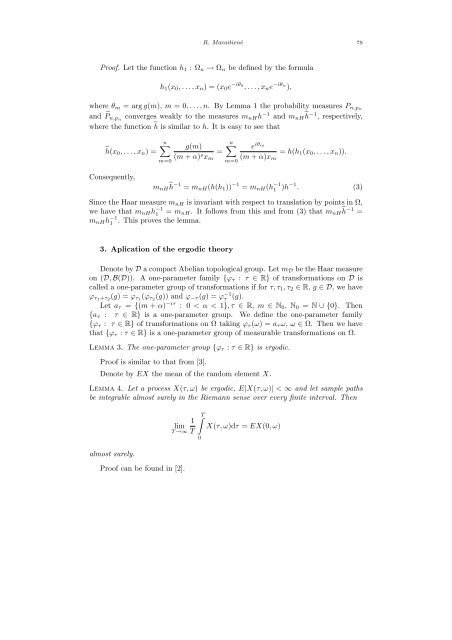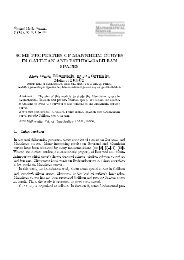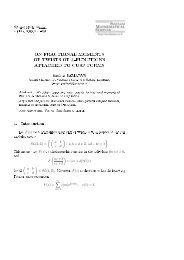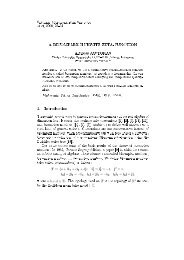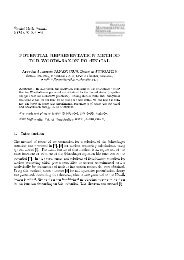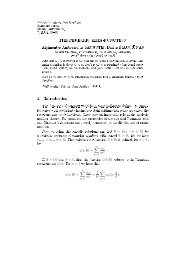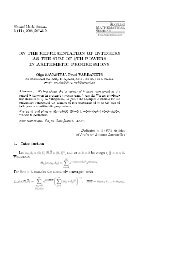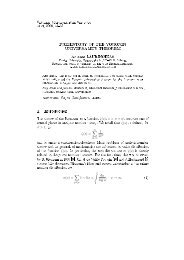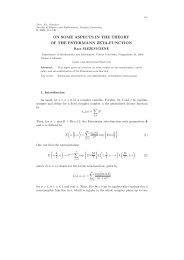a limit theorem for the hurwitz zeta-function in the space of analytic ...
a limit theorem for the hurwitz zeta-function in the space of analytic ...
a limit theorem for the hurwitz zeta-function in the space of analytic ...
Create successful ePaper yourself
Turn your PDF publications into a flip-book with our unique Google optimized e-Paper software.
R. Macaitienė 79<br />
Pro<strong>of</strong>. Let <strong>the</strong> <strong>function</strong> h 1 : Ω n → Ω n be def<strong>in</strong>ed by <strong>the</strong> <strong>for</strong>mula<br />
h 1 (x 0 , . . . , x n ) = (x 0 e −iθ 0<br />
, . . . , x n e −iθ n<br />
),<br />
where θ m = arg g(m), m = 0, . . . , n. By Lemma 1 <strong>the</strong> probability measures P n,pn<br />
and ˜P n,pn converges weakly to <strong>the</strong> measures m nH h −1 and m nH˜h−1 , respectively,<br />
where <strong>the</strong> <strong>function</strong> ˜h is similar to h. It is easy to see that<br />
˜h(x0 , . . . , x n ) =<br />
Consequently,<br />
n∑<br />
m=0<br />
g(m)<br />
(m + α) s x m<br />
=<br />
n∑<br />
m=0<br />
e iθm<br />
(m + α)x m<br />
= h(h 1 (x 0 , . . . , x n )).<br />
m nH˜h−1 = m nH (h(h 1 )) −1 = m nH (h −1<br />
1 )h−1 . (3)<br />
S<strong>in</strong>ce <strong>the</strong> Haar measure m nH is <strong>in</strong>variant with respect to translation by po<strong>in</strong>ts <strong>in</strong> Ω,<br />
we have that m nH h −1<br />
1 = m nH . It follows from this and from (3) that m nH˜h−1 =<br />
m nH h −1<br />
1 . This proves <strong>the</strong> lemma.<br />
3. Aplication <strong>of</strong> <strong>the</strong> ergodic <strong>the</strong>ory<br />
Denote by D a compact Abelian topological group. Let m D be <strong>the</strong> Haar measure<br />
on (D, B(D)). A one-parameter family {ϕ τ : τ ∈ R} <strong>of</strong> trans<strong>for</strong>mations on D is<br />
called a one-parameter group <strong>of</strong> trans<strong>for</strong>mations if <strong>for</strong> τ, τ 1 , τ 2 ∈ R, g ∈ D, we have<br />
ϕ τ1 +τ 2<br />
(g) = ϕ τ1 (ϕ τ2 (g)) and ϕ −τ (g) = ϕ −1<br />
τ (g).<br />
Let a τ = {(m + α) −iτ : 0 < α < 1}, τ ∈ R, m ∈ N 0 , N 0 = N ∪ {0}. Then<br />
{a τ : τ ∈ R} is a one-parameter group. We def<strong>in</strong>e <strong>the</strong> one-parameter family<br />
{ϕ τ : τ ∈ R} <strong>of</strong> trans<strong>for</strong>mations on Ω tak<strong>in</strong>g ϕ τ (ω) = a τ ω, ω ∈ Ω. Then we have<br />
that {ϕ τ : τ ∈ R} is a one-parameter group <strong>of</strong> measurable trans<strong>for</strong>mations on Ω.<br />
Lemma 3. The one-parameter group {ϕ τ : τ ∈ R} is ergodic.<br />
Pro<strong>of</strong> is similar to that from [3].<br />
Denote by EX <strong>the</strong> mean <strong>of</strong> <strong>the</strong> random element X.<br />
Lemma 4. Let a process X(τ, ω) be ergodic, E|X(τ, ω)| < ∞ and let sample paths<br />
be <strong>in</strong>tegrable almost surely <strong>in</strong> <strong>the</strong> Riemann sense over every f<strong>in</strong>ite <strong>in</strong>terval. Then<br />
almost surely.<br />
Pro<strong>of</strong> can be found <strong>in</strong> [2].<br />
∫<br />
1<br />
T<br />
lim X(τ, ω)dτ = EX(0, ω)<br />
T →∞ T<br />
0


